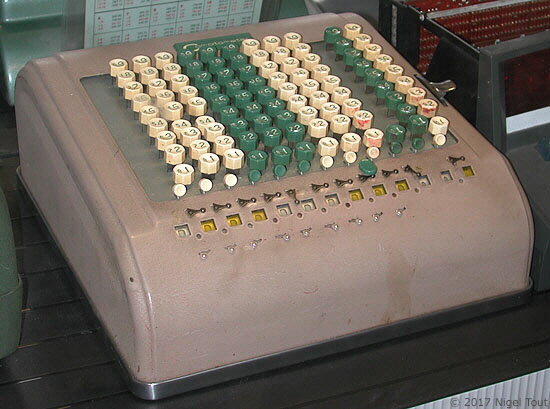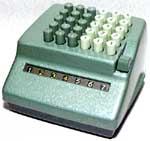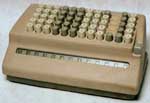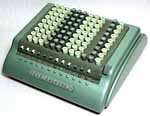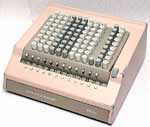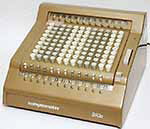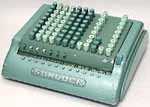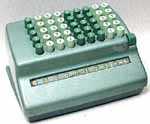Comptometer
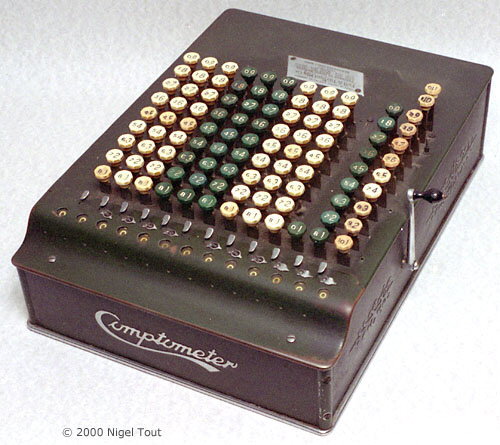
Model J, British Sterling currency (£sd), Comptometer.
Comptometer model J
The full-keyboard, British Sterling currency (£sd), Comptometer illustrated above was made by the Felt & Tarrant Manufacturing Co. in the USA in the 1920s or 30s. This is a model J, serial number J331518.
Size: 310 mm wide, 375 mm deep, 150 mm high (12.5" x 15" x 6"), 11.5 Kg (25.5 lbs).
This example is a British Sterling currency (£sd) version (click here for more details of Sterling currency calculators). It has non-standard numbers of keys in some columns (see photograph below), from left to right :-
- 9 Pound (£) columns each with nine keys (1-9),
- a column for tens of Shillings (s) with a single key (1),
- a column for units of Shillings (s) with nine keys
- a column for Pence (d) with 11 keys (1-11)
The maximum value that can be calculated is 9,999,999,999 Pounds, 19 Shillings, and 11 Pence (ie. £9,999,999,999/19s/11d).
Standard decimal Comptometers have all columns identical with 9 keys in each (no key is required for 0).
The 2 extra keys required in the Pence column would have caused problems for manufacture on a standard production line.
Standard decimal Comptometers have all columns identical with 9 keys in each (no key is required for 0). Sterling currency machines can be used for decimal calculations by ignoring the rightmost three columns of keys.
Note that there are 2 numbers marked on each key -
- The larger one is used for addition.
- The smaller one, to the left, is used for subtraction using the "9's complement" method (or in the case of the d column "12's complement").
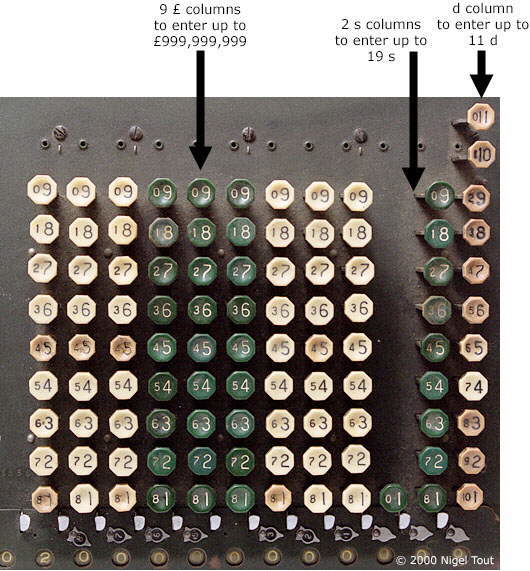
The Sterling currency keyboard.
The machine can be used in decimal mode by ignoring the three rightmost columns of keys.
Note that each key has two numbers printed on it: the larger is the number for adding, and the smaller number (to the left) is the "nines-complement" of that number (or the "12's complement in the case of the d keys) and is used for subtraction. See the article Operating a "Comptometer" in the Collecting Calculators section of this site for further information.
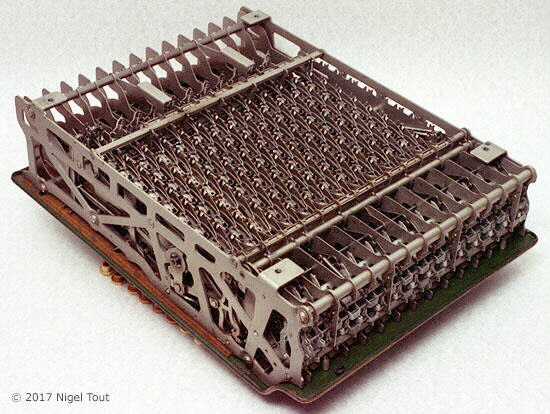
The complex mechanism of the Comptometer, seen after removing the base and turning upside down. It is largely made from numerous steel stampings, with the mechanism of each decade being similar, though with minor differences here for the shillings and pence column mechanisms.
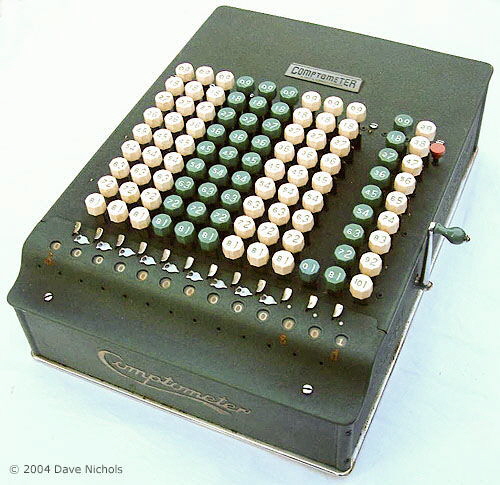
The Sterling currncy (£sd) machine pictured above is also a Comptometer model J, serial number 297617.
It is unusual because:
- It only has 9 keys in the pence column (to enter 10 or 11 you have to press one key then another which add up to the required value.
- It has later model style, thick keys.
- It has a later model style "Comptometer" badge at the rear of the keys, rather than the usual "Felt and Tarrant" badge.
These indicate that this machine may have been refurbished in the 1950s or 1960s, as explained by Ray Mackay in the "Refurbed machines..." section at the bottom of the page at the Comptometer site.
A Sterling currency (£sd) Comptometer 992. The electric motor driven 992 was introduced in 1950. After WWII, machines for Britain and Commonwealth were usually assembled in Britain from parts sourced locally and from Chicago. (Photographed during a visit to the National Museum of Computing, Bletchley Park, UK.)
The Comptometer
The Comptometer was invented by the American Dorr Eugene Felt and was patented in 1887. Manufactured by the Felt and Tarrant Manufacturing Company of Chicago, the Comptometer was the first truly practical and commercially successful adding machine, with the first serious manufacture and sales occurring in 1888.
The Comptometer proved very successful and sold widely to companies, especially for use in accounting departments. They were not intended to be personal calculators and were large and expensive. Comptometers were developed and manufactured in large numbers into the early 1970s where they were displaced in companies more by computers than by electronic calculators.
A major shortcoming of the Comptometer was that it did not provide a printed record of the calculation. Development started early on of a printing version of the Comptometer called the Comptograph though this was not very successful. This should not be confused with the later Comptograph which was a 10-key add-lister.
"Comptometer" eventually became to be used as a generic name for calculators of this type from other manufacturers, though strictly this is wrong.
However, to complicate matters, in 1957 the Felt and Tarrant Manufacturing Company
changed its name to Comptometer Corporation. Then in 1960 Comptometer Corporation sold its UK. operation, including the right to the Comptometer name in Britain, to Control Systems Ltd. (the parent of the Bell Punch Company),
which merged it with its own company to form Sumlock-Comptometer[1]. Comptometer Corporation then contracted with
Control Systems to have all its machines made by Bell Punch in England and shipped back to the U.S.A.[2] This resulted in all Comptometer production ceasing
in Chicago in 1961, and machines from Sumlock being marked with the Comptometer name.
The main manufacturers of Comptometer type machines were:
- Felt & Tarrant (later Comptometer Corporation, and Victor Comptometer), the original manufacturer, with example illustrated at top.
- Burroughs Adding Machine Co., Detroit, U.S.A.
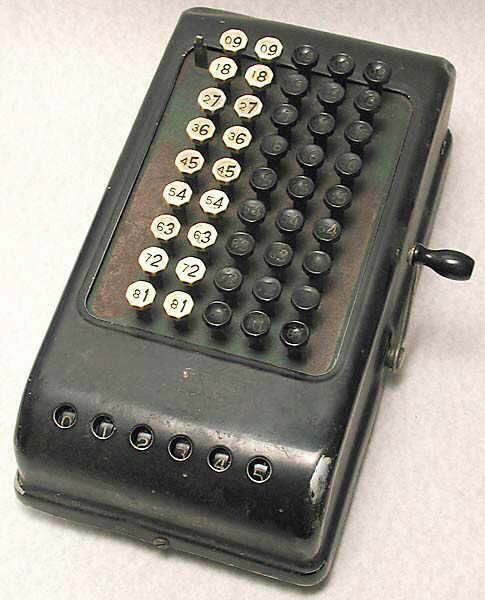
Burroughs E5 'Comptometer'-type adding machine.
- Bell Punch Co., Uxbridge, England. Sold under the names Plus, Sumlock, and Sumlock Comptometer.
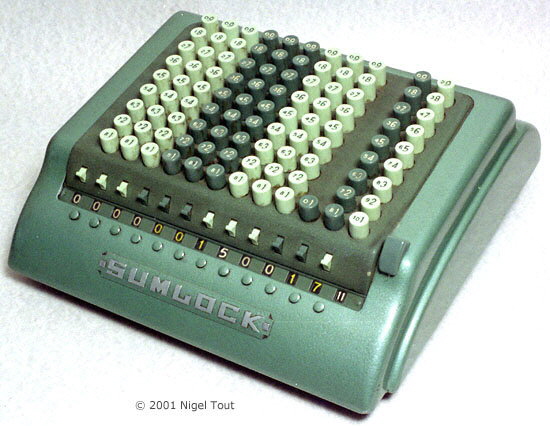
A Sumlock 912/S 'Comptometer'-type adding machine for the old British £sd currency, manufactured by the Bell Punch Company.
Comptometer type machines do not appear to have been as popular in continental Europe (add-listers, which produce a printed output, were more common there) and there were no significant manufacturers.
The Comptometer was the first successful key driven adding and calculating machine. "Key driven" means that just pressing the keys adds the numbers entered to the total - no other action is required - so it is very quick for adding long lists of numbers. The basic function of the Comptometer is addition. There is a column of keys (in general 1-9) for each decade. When a key is pressed, that number is added to that decade, with carry to the next higher decade, if applicable. Pulling the lever forwards clears the total to zero.
Comptometers were very fast in operation when adding up lists, such as required in accounting. Operators were specially trained to enter each complete number by pressing multiple keys in different columns in one go using
separate fingers of both hands. In other words the digits were entered in parallel, the mechanism being able to cope with this.
In contrast a modern electronic calculator only has 10 digit keys so the digits of each number
have to be entered one at a time, serially, which is slower.
Comptometer Schools
The photographs below of Comptometer Schools illustrate the taught method of inputting numbers by pressing multiple
keys simultaneously using the fingers of both hands.
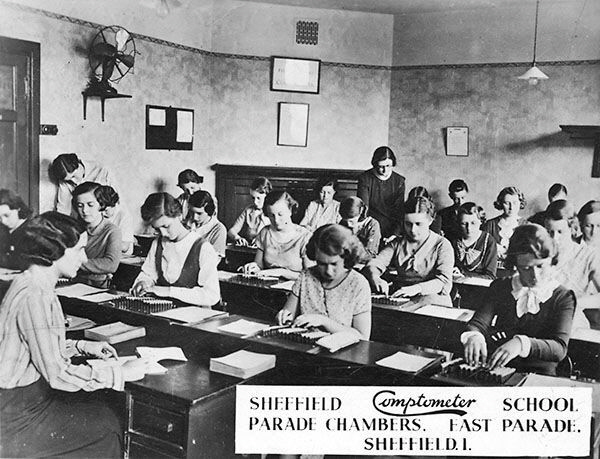
Operators training at the Comptometer School in Sheffield.
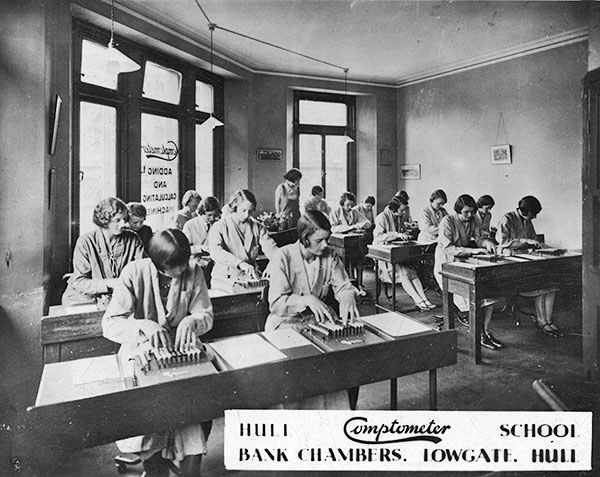
Operators training at the Comptometer School in Hull.
The journal 'Management in Action' in 1970 explained the speed advantage of the Comptometer over the 10-key electronic calculator when adding lists[3]:
"An electronic calculator is
not a substitute for an adding machine, and particularly it is not
a substitute for the key-driven machines of the Comptometer, Duplex, or Plus-adder types when they are used in an adding role.
The nub of this problem is the entry, or keying-in, time. On the abbreviated keyboard of the electronic calculator, each digit has to be entered successively, including significant 0s, to follow each other, after which a function key (+, - or =) must be pressed to activate the machine to carry out the calculation. Take, for example, the figure 39407.05. This takes nine depressions on an electronic calculator, including the decimal point and the function key.
On the key-driven (or key-actuated) adding machine [i.e. Comptometer-type machine],
each digit is entered in its appropriate column and is added at the moment of entry. Significant 0s are not
entered. Thus, for example, 39407.05 requires only five key depressions, which can be made simultaneously by a skilled operator. Thus a Comptometer operator enters the whole number in one simultaneous depression.
It follows, therefore, that in any office procedure which is
mainly adding, an abbreviated keyboard [10-key] calculator is not the best replacement machine for the key-driven mechanical machine. In fact, as yet, there are no more effective machines in the adding role than the familiar Comptometers, Duplexes, and Plus-adders, though the full keyboard Anitas (and the latest Brothers to a lesser degree) have gone some way to solving this problem. The electronic printing calculators can double as high-speed add-listers, but as such, on average, they are no faster than good electro-mechanical add-listers.
The key-driven machine remains the fastest
adding
machine, but the electronic calculator will do at least half as much again of multiplication and division, often more, and requires a much lower degree of training of operators. It follows, therefore, that in any office where the mainly
adding functions can be separated from the mainly calculating
(ie, multiplication and division) functions, then this should be done, with the 'Comps' and highly trained operators carrying out the adding, and the newer, younger, and less highly trained girls operating the electronic calculators to carry out the multiplication and division. A side product of such a policy is to minimise the re-training of Comptometer operators, with normal wastage taking care of staff replacements."
To appreciate the possible speed of operation see the video showing the Comptometer model 'K' in use.
Comptometers, were in fact, widely used into the late 1970s and were ousted by advances in the use of computers for accounting rather than the development of electronic calculators. People trained in the proper and swift use of Comptometers often kept using them for many more years since for adding up lists they were quicker than a standard ten-key electronic calculator.
Although designed mainly for addition, it is also possible to perform subtraction, multiplication, and division on Comptometers using special techniques. If you would like to experience the joy (if you are a masochist) of performing the four arithmetic functions on a Comptometer see the article Operating a "Comptometer" in the Collecting Calculators section of this site.
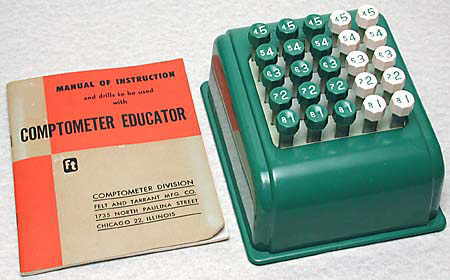
The photograph above shows a "Comptometer Educator", which is a dummy "abbreviated" Comptometer used for training purposes. It is used to practice entering complete numbers in one movement using all the fingers of the hand.
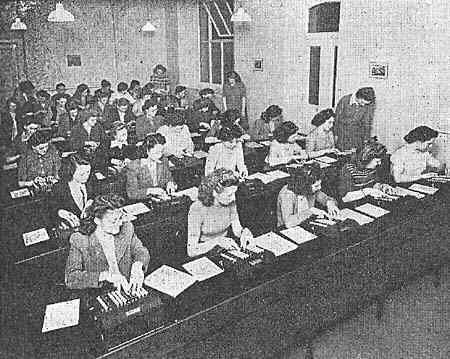
This photograph is from the journal "Office Magazine" for January 1955 and has the caption "Over 180 girls a year pass through the Liverpool school for Comptometer operators run by Felt & Tarrant Ltd. Course normally lasts three months, but there is a shorter course, provided free, which covers three weeks and deals with one specific application of the Comptometer".
Courses were run in dozens of schools for Comptometer operators (and by the Comptometer's competitors). These courses taught techniques for performing calculations quickly and efficiently.
Comptometer-type machines with 'abbreviated keyboards' were produced, as shown below. These cut down on cost by only having the keys 1 to 5 in each column, but if you need to enter a digit greater than 5 then you have to enter two numbers which add up to the digit required (e.g. for 9 press 5 then 4, for 8 press 4 then 4). Many Comptometer operators could work just as fast with an abbreviated machine since the span of the hand would cover the whole keyboard, whereas a full keyboard would be too large to allow this.
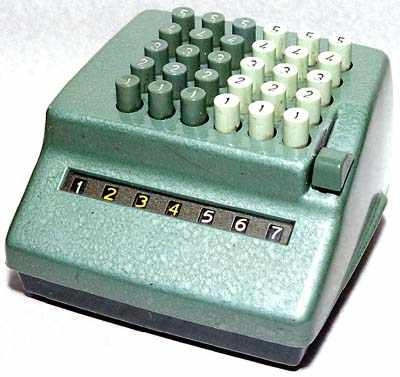
Probably the ultimate in abbreviated "Comptometers" is the Plus 506.
This is small, only 185 x 180 x 127 mm. (7.25" x 7" x 5"), and is almost a pocket 'Comptometer'.
There are instructions for the basic use of Comptometer-type machines in the article "Operating a Comptometer" on this site.
The late Brooke W. Boering ("Vagabondo") has a site which provides an excellent source of information on Felt & Tarrant Comptometers (this link directs to the site archived courtesy of the Wayback Machine).
The Digibarn Computer Museum has placed a video on YouTube which is full of information titled "Brooke Boering demonstrates Comptometers" at https://www.youtube.com/watch?time_continue=20&v=aDDAbKURGZI&feature=emb_logo. On the Digibarn site this is described "Digibarn visitor and contributor Brooke Boering does a presentation on an assorted set of comptometers, mechanical calculators made from the late 19th to the mid 20th Centuries. Brooke is an expert on the comptometer and even worked servicing them in the 1940s. Recorded: July 11, 2006."
Digibarn has a longer audio recording of Brooke Boering discussing Comptometers, made on the same occasion as the video above, at http://www.digibarn.com/collections/audio/digibarn-radio/brooke-comptometers/DigiBarn-Radio_Brooke-Boering-on-Felt-and-Tarrant-Comptometers-Jul-11-2006.mp3.
There are also excellent photographs and descriptions of the mechanism used in the "Plus" machines at John Wolff's Web Museum site at http://www.johnwolff.id.au/calculators/Comptometer/FT.htm.
For a film which shows the speed at which a trained operator could use an electric model 'K' Comptometer for adding up an invoice see "SERVICE TO THE PUBLIC - BARNSLEY BRITISH CO-OPERATIVE SOCIETY" for a short time from 5 min 40 sec. This film from 1951 also shows an interesting selection of other mechanical accounting machines.
Instructive videos about the Comptometer on Youtube include:
- "How the Comptometer works" - animated explanations of the Comptometer mechanism.
- "The Comptometer Super Totalizer, a mechanical calculator" - shows the basic operation of a Comptometer.
- "Comptometer Arithmetic" - addition, subtraction, multiplication and division.
Illustrated below are a selection of other Comptometer-type machines featured on the sister site to this one about the Bell Punch Company and its Plus and Sumlock calculators:
Click on a picture for more details and more, bigger, pictures.
Plus 506/D
Abbreviated decimal model
Plus 512/S
Abbreviated Sterling currency model
Sumlock 912/S
Sterling currency model
Sumlock Comptometer 993m
Sterling currency model
Sumlock Comptometer 993s
Electrically powered model with memory
Sumlock 912/Y
Imperial weight model
Sumlock 509/T
Time
calculation model
References:
Mechanical Calculators
Vintage Calculators
Text & photographs copyright, except where stated otherwise, © Nigel Tout 2000-2026.
